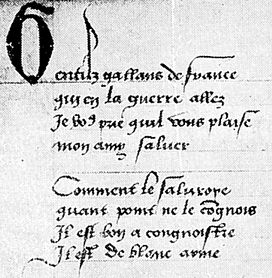Script Type : minuscule
Date : 15th century
Location : France and the Low Countries
Function : Book hand



























Distinctive letters : This example of the general late medieval French script style called bâtarde is much less formal and elegant than the previous example. Letters are more variable in form and with less extravagant variations of width of strokes. It is cursive in nature.
Ascenders of letters such as b and l tend to be loopy, although d usually has a straight backsloping form. The descender of q seems to go in the wrong direction to our eyes, making it like a g. That letter, however, has a wavy descender of variable form. The letter t is tall and pointy, rather than flat topped.
The letters u and v are differentiated, although in this example v only appears at the beginnings of words, which is often the actual differentiating factor.
The letter r appears in two forms, as in Gothic scripts, and both the tall and a closed loopy form of s appear.
The only example of j may be meant to be a capital. They used them a bit haphazardly in the 15th century.
There are no examples of k or w.
Note that, although the language is reasonably similar to the French we know today apart from the idiosyncrasies of medieval spelling, neither accents not apostrophes are used.
This is a very heartwrenching little song, and comes with music. Run the cursor slowly down the image for a taster, then proceed to the paleography exercises for the whole sorry story.
Paleography
exercises using Flash ![]()
Requires at least the Flash 5 plugin
If you are looking at this page without frames, there is more information about medieval writing to be found by going to the home page (framed) or the site map (no frames).